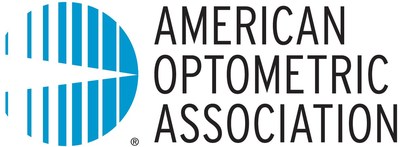ST. LOUIS, July 25, 2017 /PRNewswire-USNewswire/
-- The American Optometric Association (AOA) recently
released the newly revised Evidence-Based Clinical Practice
Guideline: Comprehensive Pediatric Eye and Vision Examination
for pediatric eye health. The guideline, based on a three-year
systematic review of the latest research, put comprehensive eye
exams on par with other annual health examinations for children.
Evidence now supports that children ages 6 to 18 years should
receive a comprehensive eye exam before entering the first grade
and annually thereafter. The comprehensive eye exam guideline has
shifted from a two-year to a one-year frequency recommendation due
to research showing the increased prevalence of eye and vision
disorders and further understanding of the significant impact eye
health has on a child's development.

The AOA is urging all parents and caregivers to begin taking
their children to a doctor of optometry for regular, in-person
comprehensive eye exams at a young age to establish a lifelong
prioritization of eye health. The AOA is concerned because many
children only receive vision screenings offered at a school or
pediatrician's office, which fail to catch a wide variety of
conditions that only a comprehensive eye exam can detect.
Good vision and overall eye health are essential in childhood
development. Poor vision can affect a child's ability to
participate in class and cause them to fall behind in their
education. It can also impact their performance in sports, among
other activities. The AOA is educating parents about how
comprehensive eye exams go beyond vision screenings commonly
offered at school or a pediatrician's office, which fail to catch a
wide variety of conditions. A doctor of optometry can diagnose and
treat any eye or vision conditions that may affect overall health,
such as glaucoma, brain damage and head trauma.
"Undiagnosed and uncorrected eye and vision problems are a
significant public health concern, which is why the AOA developed
the evidence-based guideline for comprehensive pediatric eye and
vision examinations," said Christopher
Quinn, O.D., president of the AOA. "Children are entitled to
the best care, and this guideline provides the compass for
comprehensive and improved care for children based on the
collective body of available evidence."
With summer activities in full swing and the start of school
around the corner, the AOA has compiled recommendations in line
with the new guideline to ensure eye health and safety is a
priority:
- Preschool-age children should receive at least one in-person
comprehensive eye and vision examination between the ages of 3 and
5 to prevent and/or diagnose and treat any eye or vision conditions
that may affect visual development. One in five preschoolers has a
vision problem.
- School-age children should now receive an in-person
comprehensive eye and vision examination annually to
diagnose, treat and manage any eye or vision problems. Previous
recommendations were for eye exams to occur once every two
years.
- Routine vision screenings offered at a school or pediatrician's
office are not enough. In their initial stages, many vision and eye
health conditions lack obvious signs or symptoms. Routine vision
screenings cannot be relied on to catch most vision problems. Even
if problems are detected, 61 percent of those children with a
problem will not receive appropriate follow-up. Evidence
demonstrates that the best course of action is following an annual
eye exam schedule.
- Children who experience a concussion should visit their
optometrist for a comprehensive eye exam in addition to an
appointment with their health care provider. Studies have shown
that there is a high prevalence of vision problems in children who
experience a concussion, so comprehensive eye exams are essential
in protecting their vision as well as determining if more care is
needed.
- Ocular trauma such as corneal scars, hemorrhages and folds are
often linked to child abuse and neglect. Comprehensive eye exams
play an important role in identifying signs of abuse when external
signs may be limited or nonexistent.
- Some additional updates to the guideline include information on
myopia, eye injury/protection, the benefit outdoor exposure has on
vision and the importance of ultraviolet radiation and blue light
protection.
The AOA is committed to ensuring health and safety for all
children. The new guideline is based on a three-year systematic
review in which the AOA gleaned insights from doctors of optometry
and other stakeholders in the pediatric health field, such as
pediatricians, social workers and parents. The committee
meticulously reviewed 1,475 abstracts and 353 articles, following
the AOA's 14-step evidence-based process that rates the quality of
the evidence and strength of clinical recommendations. The
guideline provides best practices on eye exam procedures and
management of conditions and diseases, among other clinical topics.
The guideline also meets the revised standards of the National
Academies of Sciences, Engineering and Medicine (formerly the
Institute of Medicine). The pediatric eye care guideline was last
reviewed and updated in 2002.
The AOA urges the public to learn about the revised guideline by
visiting www.aoa.org/childrenseyehealth. To identify doctors of
optometry who focus on pediatrics or to find additional information
on pediatric eye care, please visit www.aoa.org.
About the American Optometric Association
(AOA):
The American Optometric Association, founded
in 1898, is the leading authority on quality care and an advocate
for our nation's health, representing more than 44,000 doctors of
optometry (O.D.), optometric professionals and optometry students.
Doctors of optometry take a leading role in patient care with
respect to eye and vision care, as well as general health and
well-being. As primary health care providers, doctors of optometry
have extensive, ongoing training to examine, diagnose, treat and
manage ocular disorders, diseases and injuries and systemic
diseases that manifest in the eye. Doctors of optometry provide
more than two-thirds of primary eye care in the U.S. For more
information on eye health and vision topics, and to find a doctor
of optometry near you, visit aoa.org.
View original content with
multimedia:http://www.prnewswire.com/news-releases/optometrists-urge-families-to-prioritize-their-childrens-health-with-annual-eye-exams-300493648.html
SOURCE American Optometric Association